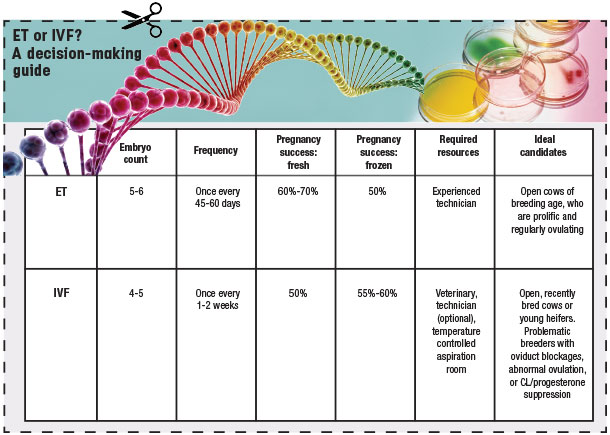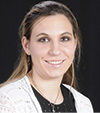Genetic progress waits for nothing, making time one of the herdsman’s most valuable assets in being competitive and profitable. The good news is: Today’s reproductive technology makes all that possible – all you need to do is make the right decisions.
Among the most powerful tools in the breeder’s toolbox are embryo transfer (ET) and in vitro fertilization (IVF). Shantille Kruse, IVF program liaison at Boviteq, explains the different merits these tools bring to different herds.
“Dairymen are seeking to improve their herd’s overall net merit and increase pregnancy success in times of heat stress,” she says of commercial herds. “Owners of young genomic animals want to create top bulls and the next generation of donors, while those on the show side are wanting offspring competitive at all levels.”
Regardless of your goals, the odds for success rely heavily on the decisions you make for each animal as an individual before investing in a procedure.
Both IVF and ET are used to accomplish the same end: improve the rate of genetic gain and reproductive efficiency by producing multiple calves per animal or bringing in outside embryos. While success rates vary, both of these have the option of being done fresh or frozen and require an experienced technician.
Laws will vary by state in regards to who can perform embryo transfer and recovery, so be sure to know them before planning the procedure. Ovum pick-up for use in IVF is technically a surgical procedure and will require a veterinarian. Kruse recommends finding one certified by the American Embryo Transfer Association. See the chart on page 63 to compare and contrast ET and IVF.
ET
This is one of the first options that comes to mind when looking to increase an animal’s efficiency and genetic gain. ET involves breeding a cow that has been super-ovulated and flushing her shortly afterward. The collected embryos can be frozen for later or freshly transferred to a recipient.
Pros: Typically, ET has the higher collection rate with an average of five to six viable embryos per flush. The pregnancy rate of recipients is also higher, with about 60 to 70 percent success when transferred fresh and around 50 percent when frozen. With that enhanced pregnancy efficiency, ET has a lower up-front cost.
ET is easily accessible to farms almost everywhere. Because it’s widely practiced, there are many experienced vets and technicians available close to home. Due to the hardiness of the embryos, ET can be done virtually anywhere since they aren’t temperature-sensitive.
Cons: This procedure can only be done every 45 to 60 days. For best odds, sexed semen will be required, which can be a disadvantage if the desired bull doesn’t have sexed semen readily available.
As with regular breeding, only one unit of semen per donor can be used at a time. In the long run, this means more straws of semen per unit if you want calves by multiple sires from a single cow or have a tricky breeder, costing more in the long run.
Use if: You want more embryos per single collection, higher conception rates and a lower up-front cost.
Great option for: Open cows, prolific and ovulating donors
Not for: Virgin heifers too young to breed, problematic breeders, pregnant cows or anovular donors
Click here or on the image above to view it at full size in a new window.
IVF
Formerly, this was reserved for cows that weren’t good ET donors. Today, this is a go-to option for many more animals, especially in 7- to 9-month-old heifers too young for breeding. IVF is similar to ET, only the cow is not bred prior to flushing. Instead, the resulting oocytes are taken to a lab and inseminated by hand before placement in the recipient. Of the two, Kruse recommends going with IVF. “Dairymen can make at least four times the genetic impact with a superior donor in a defined period using IVF instead of ET,” she says.
Pros: This can be performed on a weekly or biweekly basis, resulting in multiple flushes over a shorter period of time. Multiple oocytes from one animal can be fertilized by different sires at once. This means fewer flushes and fewer straws used per animal. IVF is also a great opportunity for donors that have done poorly in an ET program.
“Because oocytes are aspirated directly from the ovary,” Kruse explains, “oocyte pick-up and IVF can generate embryos from donors that do not work well conventionally due to oviduct issues, corpus luteum formation or progesterone maintenance.”
Thanks to reverse-sorting semen technologies, Kruse also notes IVF can procure females from non-sexed semen.
Cons: There tends to be slightly fewer viable oocytes per flush, with an average of four to five. While estimates vary, pregnancy rates tend to be slightly lower, averaging about 50 percent for fresh transfers and 55 to 60 percent for frozen, according to Kruse.
IVF oocytes are temperature-sensitive and require a clean aspiration room of at least 82ºF for collection. If a farm doesn’t have one available, animals must be transported to another farm or clinic with a viable facility.
Use if: You have a donor that has done poorly with ET, an animal too young to breed (7- to 9-month-olds) and accessible resources.
Great for: Open or up to 100 to 120 days pregnant cows and very young virgin heifers. Problematic breeders who have done poorly in ET programs due to oviduct blockage, abnormal ovulation and issues with progesterone or corpus luteum suppression are often responsive candidates.
Not for: Donors who are poor oocyte producers with low antral follicle counts either naturally or due to stress from lactation, environment, injury, disease, etc.
In choosing between ET or IVF, the decision boils down to two major factors: the individual animal and the end goals. Remember, breeding animals remains as much a gamble as any part of farming. The best way to keep the odds on your side are to make informed, confident decisions that fit your herd. ![]()
Jaclyn Krymowski was a 2017 Progressive Dairyman editorial intern.






